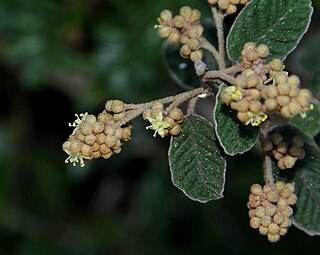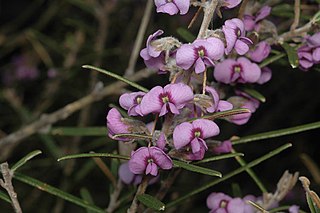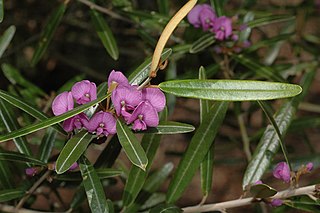
Hovea is a genus of about forty species of flowering plants in the family Fabaceae, and is endemic to Australia. Plants in this genus are sub-shrubs, shrubs or small trees with simple leaves and purple, blue or mauve flowers with a white centre. The fruit is a pod containing brown to blackish seeds. Species of Hovea occur in all Australian states, the Australian Capital Territory and the Northern Territory.

Billardiera cymosa, commonly known as sweet apple-berry or love fruit, is a species of flowering plant in the family Pittosporaceae and is endemic to south-eastern continental Australia. It is usually a slender climber that has narrowly egg-shaped leaves and pale blue or pale purplish flowers arranged in groups of about five to twelve.

Hovea linearis is a species of flowering plant in the family Fabaceae and is endemic to eastern Australia. It is an erect or trailing subshrub with mostly narrowly linear to linear leaves with stipules at the base, and mauve and yellowish-green, pea-like flowers.

Pultenaea gunnii, commonly known as golden bush-pea, is a species of flowering plant in the family Fabaceae and is endemic to south-eastern Australia. It is a slender, erect to spreading shrub with hairy young stems, egg-shaped to lance-shaped leaves with lance-shaped stipules at the base, and bright yellow and dark red flowers.

Pomaderris oraria, commonly known as Bassian dogwood, is a species of flowering plant in the family Rhamnaceae and is endemic to south-eastern Australia. It is a compact shrub with hairy branchlets, hairy, elliptic leaves and panicles of hairy, greenish to cream-coloured or crimson-tinged flowers.

Pomaderris paniculosa, commonly known as scurfy pomaderris, is a species of flowering plant in the family Rhamnaceae and is native to Australia and New Zealand. It is a shrub with hairy branchlets, round to elliptic or egg-shaped leaves with the narrower end towards the base and panicles of hairy, cream-coloured to greenish, sometimes crimson-tinged flowers.

Hovea rosmarinifolia, commonly known as mountain beauty or rosemary hovea is a shrub in the family Fabaceae, native to Australia. A small shrub bearing attractive blue-purple or mauve pea flowers from August to November.

Hovea apiculata, is a species of flowering plant in the family Fabaceae and is endemic to eastern Australia. It is a shrub with white to greyish or light brown hairs, narrowly oblong leaves with stipules at the base, and purplish and deep mauve, pea-like flowers.
Hovea corrickiae, is a species of flowering plant in the family Fabaceae and is endemic to south-eastern Australia. It is a shrub or slender tree with densely hairy branchlets, narrowly egg-shaped or elliptic, dark green leaves with stipules at the base, and mostly pale to deep mauve, pea-like flowers.
Hovea cymbiformis is a species of flowering plant in the family Fabaceae and is endemic to New South Wales. It is a shrub with foliage covered with brownish to grey hairs, narrowly elliptic leaves with stipules at the base, and mauve and yellowish-green, pea-like flowers.
Pomaderris halmaturina, commonly known as Kangaroo Island pomaderris, is a species of flowering plant in the family Rhamnaceae and is endemic to southern continental Australia. It is a shrub with narrowly elliptic to egg-shaped leaves with toothed or wavy edges, and sparse panicles of hairy, yellowish-green flowers.

Pomaderris helianthemifolia is a species of flowering plant in the family Rhamnaceae and is endemic to south-eastern continental Australia. It is a bushy shrub with hairy young stems, narrowly elliptic to lance-shaped leaves with the narrower end towards the base, and small panicles of hairy yellowish flowers.

Pomaderris ligustrina, commonly known as privet pomaderris, is a species of flowering plant in the family Rhamnaceae and is endemic to south-eastern continental Australia. It is a shrub with hairy stems, lance-shaped to narrowly elliptic leaves, and loose clusters of cream-coloured or yellow flowers.

Pomaderris phylicifolia, commonly known as narrow-leaf pomaderris, is a species of flowering plant in the family Rhamnaceae and is to south-eastern Australia and New Zealand. It is a slender shrub with hairy stems, narrowly egg-shaped to linear leaves, and small clusters of cream-coloured to yellow flowers.

Hovea lorata, is a species of flowering plant in the family Fabaceae and is endemic to eastern Australia. It is a shrub with lorate (strap-shaped) leaves, and mauve and greenish-yellow, pea-like flowers.

Hovea graniticola is a species of flowering plant in the family Fabaceae and is endemic to eastern Australia. It is a shrub with its branchlets covered with curly brownish to grey hairs, narrowly oblong to almost linear leaves with stipules at the base, and mauve, pea-like flowers.
Hovea magnibractea, is a species of flowering plant in the family Fabaceae and is endemic to south-eastern Australia. It is a shrub with narrowly oblong to lorate (strap-shaped) leaves, and mauve and yellow, pea-like flowers.

Hovea similis is a species of flowering plant in the family Fabaceae and grows in New South Wales and Queensland. It is a shrub or small tree with hairy foliage and mauve and yellowish-green pea-like flowers.
Stenanthemum notiale is a species of flowering plant in the family Rhamnaceae and is native to Western Australia, South Australia and Victoria. It is a small, erect to prostrate shrub with hairy young stems, egg-shaped leaves with the narrower end towards the base, and clusters of white to cream-coloured or greenish yellow, densely shaggy-hairy flowers.

Senna cardiosperma is a species of flowering plant in the family Fabaceae and is endemic to the western half of Australia. It is an erect shrub or small tree with pinnate leaves, the number and shape of the leaflets depending on subspecies, yellow flowers with ten fertile stamens in each flower, and flat pods.















